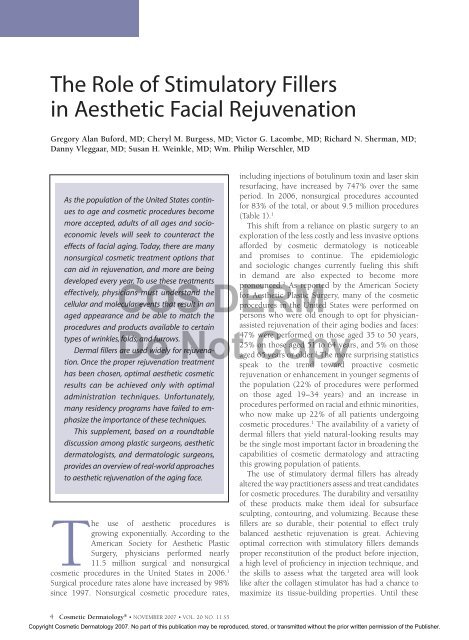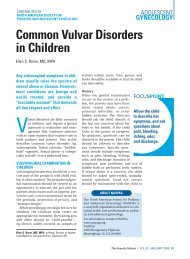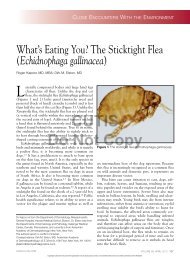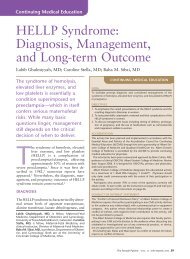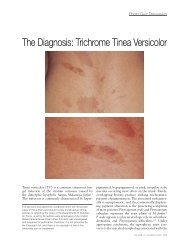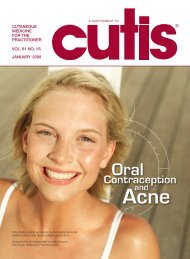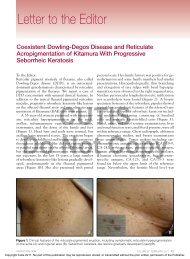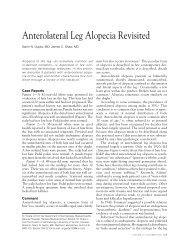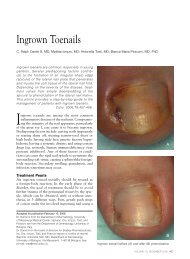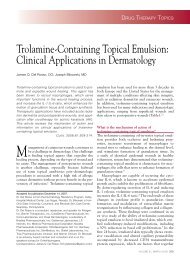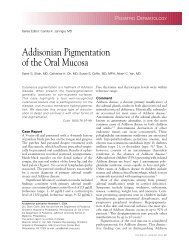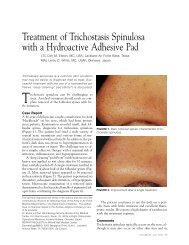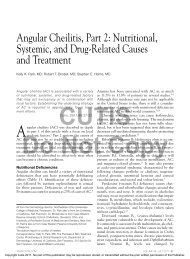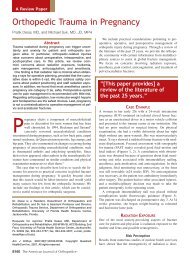The Role of Stimulatory Fillers in Aesthetic Facial Rejuvenation
The Role of Stimulatory Fillers in Aesthetic Facial Rejuvenation
The Role of Stimulatory Fillers in Aesthetic Facial Rejuvenation
You also want an ePaper? Increase the reach of your titles
YUMPU automatically turns print PDFs into web optimized ePapers that Google loves.
<strong>The</strong> <strong>Role</strong> <strong>of</strong> <strong>Stimulatory</strong> <strong>Fillers</strong><br />
<strong>in</strong> <strong>Aesthetic</strong> <strong>Facial</strong> <strong>Rejuvenation</strong><br />
Gregory Alan Buford, MD; Cheryl M. Burgess, MD; Victor G. Lacombe, MD; Richard N. Sherman, MD;<br />
Danny Vleggaar, MD; Susan H. We<strong>in</strong>kle, MD; Wm. Philip Werschler, MD<br />
As the population <strong>of</strong> the United States cont<strong>in</strong>ues<br />
to age and cosmetic procedures become<br />
more accepted, adults <strong>of</strong> all ages and socioeconomic<br />
levels will seek to counteract the<br />
effects <strong>of</strong> facial ag<strong>in</strong>g. Today, there are many<br />
nonsurgical cosmetic treatment options that<br />
can aid <strong>in</strong> rejuvenation, and more are be<strong>in</strong>g<br />
developed every year. To use these treatments<br />
effectively, physicians must understand the<br />
<strong>The</strong> use <strong>of</strong> aesthetic procedures is<br />
grow<strong>in</strong>g exponentially. Accord<strong>in</strong>g to the<br />
American Society for <strong>Aesthetic</strong> Plastic<br />
Surgery, physicians performed nearly<br />
11.5 million surgical and nonsurgical<br />
cosmetic procedures <strong>in</strong> the United States <strong>in</strong> 2006. 1<br />
Surgical procedure rates alone have <strong>in</strong>creased by 98%<br />
s<strong>in</strong>ce 1997. Nonsurgical cosmetic procedure rates,<br />
<strong>in</strong>clud<strong>in</strong>g <strong>in</strong>jections <strong>of</strong> botul<strong>in</strong>um tox<strong>in</strong> and laser sk<strong>in</strong><br />
resurfac<strong>in</strong>g, have <strong>in</strong>creased by 747% over the same<br />
period. In 2006, nonsurgical procedures accounted<br />
for 83% <strong>of</strong> the total, or about 9.5 million procedures<br />
(Table 1). 1<br />
This shift from a reliance on plastic surgery to an<br />
exploration <strong>of</strong> the less costly and less <strong>in</strong>vasive options<br />
afforded by cosmetic dermatology is noticeable<br />
and promises to cont<strong>in</strong>ue. <strong>The</strong> epidemiologic<br />
and sociologic changes currently fuel<strong>in</strong>g this shift<br />
<strong>in</strong> demand are also expected to become more<br />
pronounced. 2 As reported by the American Society<br />
for <strong>Aesthetic</strong> Plastic Surgery, many <strong>of</strong> the cosmetic<br />
procedures <strong>in</strong> the United States were performed on<br />
COS DERM<br />
cellular and molecular events that result <strong>in</strong> an<br />
aged appearance and be able to match the persons who were old enough to opt for physicianassisted<br />
rejuvenation <strong>of</strong> their ag<strong>in</strong>g bodies and faces:<br />
procedures and products available to certa<strong>in</strong><br />
Do Not<br />
47%<br />
Copy<br />
types <strong>of</strong> wr<strong>in</strong>kles, folds, and furrows.<br />
were performed on those aged 35 to 50 years,<br />
25% on those aged 51 to 64 years, and 5% on those<br />
Dermal fillers are used widely for rejuvena-<br />
aged 65 years or older. 1 <strong>The</strong> more surpris<strong>in</strong>g statistics<br />
tion. Once the proper rejuvenation treatment<br />
has been chosen, optimal aesthetic cosmetic<br />
results can be achieved only with optimal<br />
adm<strong>in</strong>istration techniques. Unfortunately,<br />
many residency programs have failed to emphasize<br />
the importance <strong>of</strong> these techniques.<br />
This supplement, based on a roundtable<br />
discussion among plastic surgeons, aesthetic<br />
dermatologists, and dermatologic surgeons,<br />
provides an overview <strong>of</strong> real-world approaches<br />
to aesthetic rejuvenation <strong>of</strong> the ag<strong>in</strong>g face.<br />
speak to the trend toward proactive cosmetic<br />
rejuvenation or enhancement <strong>in</strong> younger segments <strong>of</strong><br />
the population (22% <strong>of</strong> procedures were performed<br />
on those aged 19–34 years) and an <strong>in</strong>crease <strong>in</strong><br />
procedures performed on racial and ethnic m<strong>in</strong>orities,<br />
who now make up 22% <strong>of</strong> all patients undergo<strong>in</strong>g<br />
cosmetic procedures. 1 <strong>The</strong> availability <strong>of</strong> a variety <strong>of</strong><br />
dermal fillers that yield natural-look<strong>in</strong>g results may<br />
be the s<strong>in</strong>gle most important factor <strong>in</strong> broaden<strong>in</strong>g the<br />
capabilities <strong>of</strong> cosmetic dermatology and attract<strong>in</strong>g<br />
this grow<strong>in</strong>g population <strong>of</strong> patients.<br />
<strong>The</strong> use <strong>of</strong> stimulatory dermal fillers has already<br />
altered the way practitioners assess and treat candidates<br />
for cosmetic procedures. <strong>The</strong> durability and versatility<br />
<strong>of</strong> these products make them ideal for subsurface<br />
sculpt<strong>in</strong>g, contour<strong>in</strong>g, and volumiz<strong>in</strong>g. Because these<br />
fillers are so durable, their potential to effect truly<br />
balanced aesthetic rejuvenation is great. Achiev<strong>in</strong>g<br />
optimal correction with stimulatory fillers demands<br />
proper reconstitution <strong>of</strong> the product before <strong>in</strong>jection,<br />
a high level <strong>of</strong> pr<strong>of</strong>iciency <strong>in</strong> <strong>in</strong>jection technique, and<br />
the skills to assess what the targeted area will look<br />
like after the collagen stimulator has had a chance to<br />
maximize its tissue-build<strong>in</strong>g properties. Until these<br />
4 Cosmetic Dermatology ® • november 2007 • Vol. 20 No. 11 s5<br />
Copyright Cosmetic Dermatology 2007. No part <strong>of</strong> this publication may be reproduced, stored, or transmitted without the prior written permission <strong>of</strong> the Publisher.
<strong>Stimulatory</strong> <strong>Fillers</strong><br />
Table 1<br />
<strong>The</strong> Top 5 Nonsurgical<br />
Cosmetic Procedures <strong>in</strong> 2006 1<br />
took place with<strong>in</strong> the real-world context <strong>of</strong> assess<strong>in</strong>g<br />
the face <strong>of</strong> a typical candidate for facial rejuvenation.<br />
This supplement summarizes that discussion and<br />
<strong>in</strong>cludes a posttreatment assessment <strong>of</strong> the results <strong>of</strong><br />
the patient’s rejuvenation procedures.<br />
Procedure<br />
Botul<strong>in</strong>um tox<strong>in</strong> <strong>in</strong>jections<br />
Hyaluronic acid fillers<br />
Laser hair removal<br />
Number<br />
Performed<br />
3.18 million<br />
1.59 million<br />
1.47 million<br />
Microdermabrasion 993,000<br />
Laser sk<strong>in</strong> resurfac<strong>in</strong>g 576,000<br />
pr<strong>of</strong>iciencies are consistently reflected <strong>in</strong> the standard<br />
<strong>of</strong> care, the threat <strong>of</strong> long-last<strong>in</strong>g suboptimal correction<br />
poses a risk that many potential patients may not want<br />
to take. <strong>The</strong> versatility <strong>of</strong> stimulatory fillers—which<br />
can be used alone, <strong>in</strong> comb<strong>in</strong>ation with replacement<br />
fillers, or as adjuncts to plastic surgery—is prompt<strong>in</strong>g<br />
plastic and dermatologic surgeons to forge pr<strong>of</strong>essional<br />
alliances to bridge the gap between their respective<br />
COS DERM<br />
led to the realization that dermal fillers could be<br />
areas <strong>of</strong> practice. This collaboration has the power designed to work <strong>in</strong> tandem with the body’s own<br />
to yield a greater array <strong>of</strong> options to patients as well physiologic processes to stimulate the growth <strong>of</strong><br />
as erect a strong theoretical<br />
Do<br />
foundation<br />
Not<br />
on which to endogenous<br />
Copy<br />
tissue. Until then, dermal fillers had been<br />
build educational and tra<strong>in</strong><strong>in</strong>g curricula for the next viewed as <strong>in</strong>ert substances that effected immediate<br />
generation <strong>of</strong> skilled practitioners.<br />
change <strong>in</strong> the face by replac<strong>in</strong>g lost volume or<br />
This supplement is based on a roundtable meet<strong>in</strong>g<br />
held <strong>in</strong> February 2007 at which a panel <strong>of</strong> plastic<br />
surgeons, aesthetic dermatologists, and dermatologic<br />
surgeons convened to consider the use <strong>of</strong> dermal fillers<br />
<strong>in</strong> aesthetic rejuvenation. More specifically, the panel<br />
members shared their experiences with reconstitution<br />
and <strong>in</strong>jection techniques for poly-L-lactic acid (PLLA),<br />
a semipermanent agent that stimulates neocollagenesis<br />
and produces long-last<strong>in</strong>g results. <strong>The</strong>ir discussions<br />
Current Controversy:<br />
Classification <strong>of</strong> Dermal <strong>Fillers</strong><br />
Fat is the oldest <strong>of</strong> the dermal fillers. Its transfer from<br />
areas <strong>of</strong> relative abundance <strong>in</strong> the body to areas <strong>in</strong> need<br />
<strong>of</strong> augmentation was first reported <strong>in</strong> 1893. 3,4 By the<br />
1970s, physicians were us<strong>in</strong>g viscous fluids, such as<br />
silicone, to plump the face. In 1981, the US Food and<br />
Drug Adm<strong>in</strong>istration (FDA) advanced the capabilities<br />
<strong>of</strong> cosmetic dermatology by approv<strong>in</strong>g collagen<br />
derived from animal sources for use <strong>in</strong> the correction<br />
<strong>of</strong> wr<strong>in</strong>kles associated with the sk<strong>in</strong>’s loss <strong>of</strong> natural<br />
collagen. 5 Hyaluronic acid (HA), which restores facial<br />
volume by attract<strong>in</strong>g and b<strong>in</strong>d<strong>in</strong>g water, ga<strong>in</strong>ed FDA<br />
approval <strong>in</strong> 2004. 6 Up through the <strong>in</strong>troduction <strong>of</strong> HA,<br />
the classification <strong>of</strong> dermal fillers was based on the<br />
duration <strong>of</strong> their effects, which were either temporary,<br />
semipermanent, or permanent (Table 2). 1<br />
<strong>The</strong> 2004 approval <strong>of</strong> PLLA for facial lipoatrophy<br />
related to human immunodeficiency virus <strong>in</strong>fection 7<br />
add<strong>in</strong>g desired volume simply by occupy<strong>in</strong>g space.<br />
<strong>The</strong> idea that a dermal filler could <strong>in</strong>crease volume<br />
gradually through dynamic biologic processes,<br />
such as <strong>in</strong>itiat<strong>in</strong>g s<strong>of</strong>t tissue growth, <strong>in</strong>creas<strong>in</strong>g the<br />
exist<strong>in</strong>g tissue growth rate, or reduc<strong>in</strong>g s<strong>of</strong>t tissue<br />
breakdown, led to a change <strong>in</strong> the way dermal fillers<br />
were categorized (Table 3).<br />
This classification scheme is not without<br />
controversy, as evidenced by the recent implication<br />
Table 2<br />
Dermal <strong>Fillers</strong>: Categorized by Duration <strong>of</strong> Effect*<br />
Temporary Semipermanent Permanent<br />
Fat PLLA Comb<strong>in</strong>ations <strong>of</strong> collagen and PMMA<br />
Collagen CaHA Silicone<br />
HA<br />
Polyalkylimide hydrogel<br />
*HA <strong>in</strong>dicates hyaluronic acid; PLLA, poly-L-lactic acid; CaHA, calcium hydroxylapatite; PMMA, polymethylmethacrylate.<br />
Vol. 20 No. 11 s5 • november 2007 • Cosmetic Dermatology ® 5<br />
Copyright Cosmetic Dermatology 2007. No part <strong>of</strong> this publication may be reproduced, stored, or transmitted without the prior written permission <strong>of</strong> the Publisher.
<strong>Stimulatory</strong> <strong>Fillers</strong><br />
Table 3<br />
Dermal <strong>Fillers</strong>: Replacement<br />
Versus Collagen Stimulators*<br />
Replacement<br />
<strong>Fillers</strong><br />
Fat<br />
Collagen<br />
HA<br />
Polyalkylimide hydrogel<br />
Collagen<br />
Stimulators<br />
CaHA<br />
Comb<strong>in</strong>ations <strong>of</strong><br />
collagen and PMMA<br />
PLLA<br />
Silicone<br />
*HA <strong>in</strong>dicates hyaluronic acid; CaHA, calcium hydroxylapatite;<br />
PMMA, polymethylmethacrylate; PLLA, poly-L-lactic acid.<br />
<strong>of</strong> HA <strong>in</strong> fibroplasia and collagen production. A<br />
recent cl<strong>in</strong>ical study concluded that HA did stimulate<br />
collagen synthesis, probably by <strong>in</strong>duc<strong>in</strong>g mechanical<br />
stretch<strong>in</strong>g <strong>of</strong> the dermis and, <strong>in</strong> turn, stretch<strong>in</strong>g and<br />
activat<strong>in</strong>g dermal fibroblasts. 8 However, <strong>in</strong> vitro tests<br />
COS DERM<br />
excess sk<strong>in</strong> beg<strong>in</strong>s to sag. 12 Fat atrophy affects the<br />
suggested that HA is not directly stimulatory, as it periorbital, forehead, buccal, temporal, and perioral<br />
did not b<strong>in</strong>d the filler. For our purposes, it is less areas. Loss <strong>of</strong> fat under the lower eyelids causes a<br />
important how <strong>in</strong>dividual<br />
Do<br />
agents are<br />
Not<br />
classified than sunken<br />
Copy<br />
appearance <strong>of</strong> the eyes, and loss <strong>of</strong> cheek fat<br />
that a variety <strong>of</strong> dermal fillers with different properties, causes a gaunt appearance. 13 Hypertrophy causes fat<br />
mechanisms <strong>of</strong> action, sites <strong>of</strong> optimum efficacy, and to accumulate <strong>in</strong> the submental area, jowl, lateral<br />
durations are available to help practitioners achieve<br />
aesthetic facial rejuvenation. We have, <strong>in</strong> essence,<br />
determ<strong>in</strong>ed to rely on a fairly traditional categorization<br />
<strong>of</strong> fillers as temporary, semipermanent, or permanent<br />
and accorded HA the status <strong>of</strong> a stimulatory filler<br />
while reserv<strong>in</strong>g judgment on whether it actually<br />
stimulates neocollagenesis.<br />
Assess<strong>in</strong>g the Face<br />
Before plann<strong>in</strong>g the course <strong>of</strong> rejuvenation, the<br />
physician must assess the face for signs <strong>of</strong> ag<strong>in</strong>g<br />
while tak<strong>in</strong>g a variety <strong>of</strong> factors <strong>in</strong>to consideration.<br />
Although the patient’s primary concern may be to<br />
improve the appearance by reduc<strong>in</strong>g the signs <strong>of</strong><br />
ag<strong>in</strong>g, the physician may need to enumerate the signs<br />
<strong>of</strong> ag<strong>in</strong>g, discuss how they are assessed, and determ<strong>in</strong>e<br />
whether or to what degree those signs can be modified<br />
by available treatment options. Peripheral concerns<br />
must be brought center stage and addressed before<br />
treatment can beg<strong>in</strong>. <strong>The</strong>se concerns run the gamut<br />
from the need to treat frank or <strong>in</strong>cipient sk<strong>in</strong> cancers<br />
to discuss<strong>in</strong>g how the current treatment might affect<br />
ag<strong>in</strong>g <strong>in</strong> the future. Honestly assess<strong>in</strong>g what the<br />
patient can afford <strong>in</strong> terms <strong>of</strong> cost and recovery time<br />
is also important. <strong>The</strong> most successful assessments<br />
conclude with the patient and physician agree<strong>in</strong>g<br />
on a plan for facial rejuvenation that is realistic<br />
and comprehensive <strong>in</strong> its attention to preserv<strong>in</strong>g<br />
facial balance. It is important to note that the<br />
duration <strong>of</strong> results varies depend<strong>in</strong>g on the products<br />
used, the procedures performed, and the patient’s<br />
health and lifestyle choices. 9 Gett<strong>in</strong>g the patient to<br />
understand that facial rejuvenation is ultimately a<br />
work <strong>in</strong> progress is crucial to the establishment <strong>of</strong><br />
realistic expectations.<br />
<strong>Facial</strong> Ag<strong>in</strong>g<br />
Many factors contribute to an aged facial appearance.<br />
Superficial changes <strong>in</strong>clude alterations <strong>in</strong> pigmentation,<br />
texture, and hair growth 10 ; dull<strong>in</strong>g <strong>of</strong> the sk<strong>in</strong> due<br />
to slow turnover <strong>of</strong> sk<strong>in</strong> cells; and the presence <strong>of</strong><br />
keratoses, lentig<strong>in</strong>es, redness, and telangiectasias.<br />
Extensive subsurface changes that result <strong>in</strong> volume<br />
loss, <strong>in</strong>clud<strong>in</strong>g bone resorption, muscle atrophy, and<br />
fat redistribution, are also <strong>of</strong> paramount concern. 10<br />
With ag<strong>in</strong>g, fat redistribution changes facial contours,<br />
as the smooth primary arcs and convexities <strong>of</strong> the<br />
young face reshape <strong>in</strong>to hills and valleys. 11 <strong>The</strong> loss<br />
<strong>of</strong> fat converts primary arcs to straighter l<strong>in</strong>es, and<br />
nasolabial fold, labiomental crease, and malar area. 12<br />
<strong>The</strong> lower half <strong>of</strong> the face becomes heavy, with sagg<strong>in</strong>g<br />
and droop<strong>in</strong>g <strong>in</strong> the jowl area and under the ch<strong>in</strong>.<br />
Because fat plays such an important role <strong>in</strong> facial<br />
appearance, the restoration <strong>of</strong> youthful fat distribution<br />
is a primary goal <strong>in</strong> facial rejuvenation. 12<br />
Ideally, the physician should have access to<br />
photographs <strong>of</strong> the patient <strong>in</strong> his or her youth. Be<strong>in</strong>g<br />
able to see the specific changes wrought on a face by<br />
age, photodamage, and, possibly, a previous plastic<br />
surgery gives the physician an aesthetic ideal to which<br />
to aspire. <strong>The</strong> aesthetic is specific to the patient and<br />
allows for a realistic appraisal <strong>of</strong> what is possible.<br />
Case History: Assessment<br />
<strong>The</strong> patient is a 63-year-old woman with Fitzpatrick<br />
sk<strong>in</strong> type II. She will tan with careful sun exposure<br />
but has not tried to tan s<strong>in</strong>ce her 20s and wears<br />
sunscreen every day at the recommendation <strong>of</strong> her<br />
doctor. She has had a procedure to freeze an emerg<strong>in</strong>g<br />
act<strong>in</strong>ic keratosis on her nose, but no other cosmetic<br />
procedures. She considers her wr<strong>in</strong>kl<strong>in</strong>g m<strong>in</strong>or but<br />
is concerned about heavy eyelids, hollows under the<br />
eyes, and some jowl<strong>in</strong>g.<br />
6 Cosmetic Dermatology ® • november 2007 • Vol. 20 No. 11 s5<br />
Copyright Cosmetic Dermatology 2007. No part <strong>of</strong> this publication may be reproduced, stored, or transmitted without the prior written permission <strong>of</strong> the Publisher.
<strong>Stimulatory</strong> <strong>Fillers</strong><br />
Figure not<br />
available onl<strong>in</strong>e<br />
Figure not<br />
available onl<strong>in</strong>e<br />
Figure not<br />
available onl<strong>in</strong>e<br />
A B C<br />
Figure 1. Pretreatment evidence <strong>of</strong> ag<strong>in</strong>g <strong>in</strong> a 63-year-old woman from 3 perspectives: right lateral (A), frontal (B), and left<br />
lateral (C) views.<br />
Photographs were taken before treatment at<br />
various angles aga<strong>in</strong>st a neutral background with<br />
consistent light<strong>in</strong>g to avoid shadows so that results<br />
can be reviewed and compared over time (Figure 1).<br />
Each series <strong>of</strong> photographs taken throughout the<br />
rejuvenation process should, ideally, have 5 views:<br />
frontal, left and right lateral, and left and right oblique.<br />
Photographs can also be useful when expla<strong>in</strong><strong>in</strong>g<br />
procedures to patients.<br />
Superficial Changes<br />
<strong>The</strong> panel agreed that the patient showed evidence <strong>of</strong><br />
photodamage, particularly on the neck, which required<br />
that she be exam<strong>in</strong>ed and treated for precancerous and<br />
cancerous lesions before undergo<strong>in</strong>g any aesthetic<br />
procedures. It was also recommended that she<br />
wear sunblock every day to protect aga<strong>in</strong>st further<br />
photodamage. <strong>The</strong> panel then weighed the specifics<br />
<strong>of</strong> how facial rejuvenation would be achieved. Each<br />
panelist was m<strong>in</strong>dful <strong>of</strong> the effect that a proposed<br />
correction would have on the patient’s appearance<br />
and took care to suggest compensatory corrections to<br />
ma<strong>in</strong>ta<strong>in</strong> the overall balance <strong>of</strong> her face.<br />
When queried by the moderator about the nature<br />
and extent <strong>of</strong> superficial changes and how best to<br />
address them, the panelists <strong>in</strong>itially focused their<br />
comments on the m<strong>in</strong>imization or eradication <strong>of</strong> signs<br />
<strong>of</strong> photodamage and rhytides.<br />
Photodamage<br />
Dr. Burgess: I would use a trichloroacetic acid<br />
peel or erbium laser to deeply exfoliate the sk<strong>in</strong> surface<br />
and address the discoloration and the precancerous<br />
lesions.<br />
Dr. Sherman: I agree; a chemical or laser peel would<br />
help m<strong>in</strong>imize the signs <strong>of</strong> photoag<strong>in</strong>g. However, if<br />
she does not want the downtime associated with a<br />
25% or 35% trichloroacetic acid or laser peel, a series<br />
<strong>of</strong> lighter peels us<strong>in</strong>g a-hydroxy acid, b-hydroxy<br />
acid, or both may provide an alternative for treat<strong>in</strong>g<br />
sun-damaged sk<strong>in</strong>. In addition to peel<strong>in</strong>g, I would<br />
supplement treatment <strong>of</strong> focal brown spots (lentig<strong>in</strong>es)<br />
and telangiectasias with a laser such as the Vari-Lite<br />
dual-wavelength (532 nm and 940 nm) laser system.<br />
COS DERM<br />
Dr. Buford: For a less <strong>in</strong>vasive option, <strong>in</strong>tense pulsed<br />
light therapy could be used to remove the brown spots<br />
and telangiectasias and rejuvenate the sk<strong>in</strong>.<br />
Do Not Copy<br />
Rhytides<br />
Dr. Burgess: She has a few rhytides <strong>in</strong> a horizontal<br />
plane on the forehead and vertical l<strong>in</strong>es <strong>in</strong> the glabellar<br />
area and across the nose bridge. Her hyperk<strong>in</strong>etic<br />
musculature def<strong>in</strong>itely could be relaxed with<br />
botul<strong>in</strong>um tox<strong>in</strong>. Because <strong>of</strong> the laxity <strong>of</strong> her upper<br />
eyelids, botul<strong>in</strong>um tox<strong>in</strong> <strong>in</strong>jections <strong>in</strong> the forehead<br />
l<strong>in</strong>es will probably cause brow ptosis, thereby<br />
<strong>in</strong>creas<strong>in</strong>g the hood<strong>in</strong>g <strong>of</strong> her upper eyelids. Outside<br />
<strong>of</strong> us<strong>in</strong>g botul<strong>in</strong>um tox<strong>in</strong> type A to produce a browlift,<br />
I would refer her to a plastic surgeon to consider<br />
blepharoplasty. <strong>The</strong>re are also rhytides around the<br />
mouth, which could be treated with botul<strong>in</strong>um tox<strong>in</strong><br />
and any temporary filler.<br />
Dr. Sherman: I am also concerned about the heavy<br />
appearance <strong>of</strong> the upper eyelids and would recommend<br />
consultation with a plastic surgeon for blepharoplasty.<br />
In the region <strong>of</strong> the superior temples, there is a crepelike<br />
appearance to the sk<strong>in</strong> and the superior-lateral brows<br />
seem to fall downward. PLLA may be used to volumize<br />
the temples and will create a vector to help lift the lateral<br />
brows. If she opted for a face-lift, I would recommend<br />
volumization with PLLA 4 to 6 months postsurgery.<br />
Tear troughs are another prom<strong>in</strong>ent feature and may<br />
be m<strong>in</strong>imized us<strong>in</strong>g small volumes (0.25–0.05 mL) <strong>of</strong><br />
Vol. 20 No. 11 s5 • november 2007 • Cosmetic Dermatology ® 7<br />
Copyright Cosmetic Dermatology 2007. No part <strong>of</strong> this publication may be reproduced, stored, or transmitted without the prior written permission <strong>of</strong> the Publisher.
<strong>Stimulatory</strong> <strong>Fillers</strong><br />
Table 4<br />
Hyaluronic Acid*<br />
FDA approval First HA product approved by the FDA <strong>in</strong> 2004 6<br />
Components<br />
Mechanism <strong>of</strong> action<br />
Some products conta<strong>in</strong> avian HA, some manufactured by ferment<strong>in</strong>g<br />
streptococcal bacteria 5<br />
Restores volume immediately. Also acts as a sponge to attract and b<strong>in</strong>d water,<br />
ma<strong>in</strong>ta<strong>in</strong><strong>in</strong>g fullness <strong>in</strong> <strong>in</strong>jected areas for vary<strong>in</strong>g lengths <strong>of</strong> time, depend<strong>in</strong>g on<br />
specific product<br />
Duration <strong>of</strong> effect Claims <strong>of</strong> ≥4–6 mo 14<br />
Uses/advantages<br />
Best used to augment lips; fill lower eyelids, tear troughs, and wr<strong>in</strong>kles; correct f<strong>in</strong>e<br />
l<strong>in</strong>es. Effective <strong>in</strong> all areas <strong>of</strong> the face and at multiple dermal tissue depths. Structurally<br />
identical <strong>in</strong> all species; therefore, pretreatment sk<strong>in</strong> test<strong>in</strong>g not necessary 5<br />
Disadvantages<br />
Relatively short duration <strong>of</strong> results. Produces s<strong>of</strong>t volume enhancement; therefore,<br />
less suitable and less cost-effective than other products for facial contour<strong>in</strong>g. 15 Tissue<br />
<strong>in</strong>jection required, and tissue <strong>in</strong> th<strong>in</strong> areas may become discolored. Adverse<br />
events associated with the use <strong>of</strong> these products <strong>in</strong>clude non<strong>in</strong>flammatory nodules<br />
and <strong>in</strong>flammatory<br />
COS DERM<br />
granulomas<br />
Current controversy Cross-l<strong>in</strong>ked HA <strong>in</strong>jected <strong>in</strong>to forearms <strong>of</strong> 11 healthy volunteers stimulated collagen<br />
synthesis and partially restored components <strong>of</strong> the dermal matrix that had<br />
been lost to photodamage. 8 Investigators hypothesized that stimulatory effects<br />
Do<br />
were due to<br />
Not<br />
activation <strong>of</strong> dermal fibrolasts<br />
Copy<br />
and that cross-l<strong>in</strong>ked HA may have<br />
some utility <strong>in</strong> treat<strong>in</strong>g atrophic conditions. Other cl<strong>in</strong>icians warn that the collagenstimulation<br />
properties <strong>of</strong> HA have not been proven conclusively<br />
*FDA <strong>in</strong>dicates US Food and Drug Adm<strong>in</strong>istration; HA, hyaluronic acid.<br />
PLLA to create a series <strong>of</strong> vectors that would help not<br />
only elevate the depressions but also lower the eyelids.<br />
She has very prom<strong>in</strong>ent tear troughs, and us<strong>in</strong>g small<br />
volumes <strong>of</strong> PLLA to create a series <strong>of</strong> vectors would<br />
help elevate the lower eyelid area.<br />
Dr. Buford: I’m concerned that if you adequately<br />
took away the forehead transverse l<strong>in</strong>es, you might<br />
block brow compensation, which might make her<br />
feel claustrophobic, so I would use botul<strong>in</strong>um tox<strong>in</strong><br />
medially <strong>in</strong> the forehead. Botul<strong>in</strong>um tox<strong>in</strong> at the<br />
orbicularis oculi might raise her eyelids a little. In<br />
reality, though, I th<strong>in</strong>k she is a surgical patient. If she<br />
does not want surgery, she must be will<strong>in</strong>g to accept<br />
a less-than-optimal result with <strong>in</strong>jectables. I see the<br />
whole midface com<strong>in</strong>g down aga<strong>in</strong>st the mandibular<br />
ligament and aga<strong>in</strong>st the nasolabial fold, and I th<strong>in</strong>k<br />
it would be difficult to br<strong>in</strong>g that up with PLLA<br />
alone. If surgery were unacceptable, I would proceed<br />
conservatively with botul<strong>in</strong>um tox<strong>in</strong>. I would use<br />
botul<strong>in</strong>um tox<strong>in</strong> <strong>in</strong> the crow’s-feet area and medial<br />
brow but, for the previous reasons, would most likely<br />
avoid the lateral forehead.<br />
Dr. We<strong>in</strong>kle: I th<strong>in</strong>k what def<strong>in</strong>itely needs to<br />
be addressed is the glabella, because that’s what<br />
communicates stress and anger. I would use a little filler<br />
<strong>in</strong> conjunction with botul<strong>in</strong>um tox<strong>in</strong> to enhance this<br />
area. I would concentrate on relax<strong>in</strong>g the orbicularis<br />
oculi, which would lift the brow and s<strong>of</strong>ten the upper<br />
face. It’s also important to address the perioral region. I<br />
would also use some botul<strong>in</strong>um tox<strong>in</strong> <strong>in</strong> the depressor<br />
anguli oris (DAO) to turn up the mouth, as well as a<br />
filler to support the buttress <strong>of</strong> the lip to improve the<br />
overall facial appearance.<br />
Dr. Lacombe: Clearly, the forehead is a dynamic<br />
area, so I would present the patient with 2 options:<br />
have botul<strong>in</strong>um tox<strong>in</strong> <strong>in</strong>jected every 3 to 4 months<br />
or <strong>in</strong>terrupt the muscle fibers surgically. When<br />
perform<strong>in</strong>g a blepharoplasty, I make my <strong>in</strong>cision <strong>in</strong><br />
the crease. However, because her hooded upper eyelid<br />
8 Cosmetic Dermatology ® • november 2007 • Vol. 20 No. 11 s5<br />
Copyright Cosmetic Dermatology 2007. No part <strong>of</strong> this publication may be reproduced, stored, or transmitted without the prior written permission <strong>of</strong> the Publisher.
<strong>Stimulatory</strong> <strong>Fillers</strong><br />
Table 5<br />
FDA approval<br />
Components<br />
Mechanism <strong>of</strong> action<br />
Duration <strong>of</strong> effect<br />
Poly-L-lactic Acid*<br />
First brought to market <strong>in</strong> France <strong>in</strong> 1999 and promoted pr<strong>in</strong>cipally as an aesthetic<br />
treatment. Approved by the FDA <strong>in</strong> 2004 to treat HIV-related facial lipoatrophy. 7<br />
Dramatic results have led to widespread <strong>of</strong>f-label use for cosmetic rejuvenation <strong>in</strong><br />
the United States<br />
Hydrogel suspension conta<strong>in</strong><strong>in</strong>g microparticles <strong>of</strong> PLLA, an a-hydroxy acid, <strong>in</strong><br />
sterile water 16<br />
Immediate volumiz<strong>in</strong>g effect <strong>of</strong> hydrogel and water, which lasts ≤1 wk. Once carrier<br />
suspension and water are absorbed, collagenesis is stimulated and progressive<br />
volumiz<strong>in</strong>g beg<strong>in</strong>s 11<br />
Suspension gradually degrades over time, requir<strong>in</strong>g re<strong>in</strong>jection for ma<strong>in</strong>tenance<br />
<strong>of</strong> effect<br />
Uses/advantages<br />
Disadvantages<br />
Best used for sculpt<strong>in</strong>g, contour<strong>in</strong>g, and volumiz<strong>in</strong>g. Rapid adm<strong>in</strong>istration, requires<br />
little downtime; f<strong>in</strong>al results appear gradually over ≥3–5 treatments. Optimal depth<br />
<strong>of</strong> implantation is at dermal-subcutaneous junction, but can also be implanted<br />
with<strong>in</strong> superficial subcutaneous fat or just above periosteum. 7 Directly addresses<br />
COS<br />
problem <strong>of</strong> dermal atrophy;<br />
DERM<br />
improve sk<strong>in</strong>’s look and texture by produc<strong>in</strong>g natural<br />
collagen. Useful on hands, chest, and other areas, <strong>in</strong> addition to the face. Requires<br />
patient compliance with self-massage for several days after treatment to help<br />
m<strong>in</strong>imize formation <strong>of</strong> nodules and repeat <strong>in</strong>jections over 3–5 mo, usually at<br />
monthly <strong>in</strong>tervals<br />
Do Not Copy<br />
Because PLLA is a synthetic, no animal sensitivity is <strong>in</strong>volved and no pretreatment<br />
test<strong>in</strong>g is required 16<br />
Not recommended for volumiz<strong>in</strong>g lips, treat<strong>in</strong>g specific superficial wr<strong>in</strong>kles, or<br />
superficial or site-specific enhancement. More costly than other dermal fillers.<br />
Adverse effects <strong>in</strong>clude non<strong>in</strong>flammatory micropapules, papules, nodules, and<br />
<strong>in</strong>flammatory granulomas<br />
*FDA <strong>in</strong>dicates US Food and Drug Adm<strong>in</strong>istration; HIV, human immunodeficiency virus; PLLA, poly-L-lactic acid.<br />
extends <strong>in</strong> a fold past the corners <strong>of</strong> the eyes, I would<br />
have to extend the <strong>in</strong>cision further. Typically, this<br />
doesn’t heal as nicely <strong>in</strong> this thicker sk<strong>in</strong>. My solution<br />
would be to perform an endoscopic brow-lift. This<br />
would elevate the eyelid, elim<strong>in</strong>at<strong>in</strong>g the fold; then I<br />
could limit the <strong>in</strong>cision to the crease. When the eyelid<br />
<strong>in</strong>cision heals, it is hidden <strong>in</strong> this natural crease. She<br />
already has a relatively arched brow, so I would not try<br />
to lift it too much more centrally. I would use muscle<br />
transaction and excision to produce a lateral elevation,<br />
a little separation <strong>in</strong> the center, and a release around<br />
the temple. <strong>The</strong> result would be a s<strong>of</strong>ten<strong>in</strong>g <strong>of</strong> the<br />
upper half <strong>of</strong> the face. In the lower half, I get pretty<br />
good results with botul<strong>in</strong>um tox<strong>in</strong> around the DAO.<br />
I f<strong>in</strong>d that I get crisper results with HA or CaHA than<br />
with PLLA <strong>in</strong> the corners <strong>of</strong> the mouth and along the<br />
marionette l<strong>in</strong>es (Tables 4 and 5). 5-8,11,14-16 I put the<br />
filler <strong>in</strong>to the lip border and all around the corner, and<br />
the lips turn up immediately.<br />
Subsurface Changes<br />
Because the correction <strong>of</strong> the subsurface changes<br />
associated with ag<strong>in</strong>g very <strong>of</strong>ten requires extensive<br />
sculpt<strong>in</strong>g, contour<strong>in</strong>g, and volumiz<strong>in</strong>g <strong>of</strong> targeted<br />
areas, the fillers used must provide strong structural<br />
tissue support that yields a long-last<strong>in</strong>g, naturallook<strong>in</strong>g<br />
result. <strong>Stimulatory</strong> fillers <strong>of</strong>fer the best options<br />
for achiev<strong>in</strong>g these types <strong>of</strong> aesthetic goals because<br />
they are <strong>in</strong>jected deep <strong>in</strong>to the dermis and subdermis<br />
(Figure 2). In addition, each filler has its own sites <strong>of</strong><br />
Vol. 20 No. 11 s5 • november 2007 • Cosmetic Dermatology ® 9<br />
Copyright Cosmetic Dermatology 2007. No part <strong>of</strong> this publication may be reproduced, stored, or transmitted without the prior written permission <strong>of</strong> the Publisher.
<strong>Stimulatory</strong> <strong>Fillers</strong><br />
Product Name Depth <strong>of</strong> Injection FDA Indication<br />
Poly-L-lactic acid Deep dermis–subdermis Restoration or correction <strong>of</strong> HIVassociated<br />
lipoatrophy<br />
Calcium Deep dermis Oral and maxill<strong>of</strong>acial defects; vocal fold<br />
hydroxylapatite<br />
<strong>in</strong>sufficiency, radiographic tissue mark<strong>in</strong>g<br />
Collagen and Upper dermis–mid dermis; Correction <strong>of</strong> s<strong>of</strong>t tissue contours (eg,<br />
hyaluronic acids mid dermis–deep dermis those created by wr<strong>in</strong>kles and acne scars);<br />
correction <strong>of</strong> moderate to severe facial<br />
wr<strong>in</strong>kles and folds (eg, nasolabial folds)<br />
Silicone Deep dermis Prolonged ret<strong>in</strong>al tamponade <strong>in</strong> cases<br />
<strong>of</strong> complicated ret<strong>in</strong>al detachments<br />
Upper dermis<br />
Mid dermis<br />
Deep dermis<br />
COS DERM<br />
Figure not<br />
available onl<strong>in</strong>e<br />
Do Not Copy<br />
Subdermis<br />
Figure 2. Depth <strong>of</strong> <strong>in</strong>jection <strong>of</strong> various fillers. FDA <strong>in</strong>dicates US Food and Drug Adm<strong>in</strong>istration; HIV, human immunodeficiency<br />
virus. Adapted with permission from Cosmetic Dermatology. 2006;19(suppl 2). ©2006, Quadrant HealthCom Inc. Illustration by<br />
Christy Krames.<br />
optimal efficacy. (<strong>The</strong>se will be exam<strong>in</strong>ed <strong>in</strong> more detail<br />
<strong>in</strong> the Treatments section.) <strong>The</strong> ability to <strong>in</strong>ject these<br />
products to create a layered effect further enhances<br />
their versatility and the chances <strong>of</strong> achiev<strong>in</strong>g a more<br />
natural look. This versatility also makes stimulatory<br />
fillers ideal adjuncts to plastic surgery and useful<br />
elements <strong>in</strong> comb<strong>in</strong>ation treatment with botul<strong>in</strong>um<br />
tox<strong>in</strong> and HA.<br />
Because the long-term effects <strong>of</strong> stimulatory fillers<br />
occur gradually, optimum aesthetic correction is a<br />
matter <strong>of</strong> successive approximations to the ideal look.<br />
<strong>The</strong> mantra “treat, wait, and assess” should be used to<br />
guide stimulatory filler <strong>in</strong>jections <strong>in</strong> any patient. 7 <strong>The</strong><br />
usual recommendation is to schedule a reassessment<br />
for a possible second treatment 4 to 6 weeks after<br />
the first.<br />
10 Cosmetic Dermatology ® • november 2007 • Vol. 20 No. 11 s5<br />
Copyright Cosmetic Dermatology 2007. No part <strong>of</strong> this publication may be reproduced, stored, or transmitted without the prior written permission <strong>of</strong> the Publisher.
Loss and Redistribution <strong>of</strong> <strong>Facial</strong> Fat<br />
Dr. Burgess: This patient has a lot <strong>of</strong> facial fat loss<br />
around the mouth, which pushes the sk<strong>in</strong> aga<strong>in</strong>st<br />
the nasolabial folds, cupp<strong>in</strong>g the perioral region. I<br />
would recommend us<strong>in</strong>g a stimulatory filler such as<br />
PLLA <strong>in</strong> the malar and preauricular regions to pull<br />
away from the perioral region. In the midface area,<br />
she has prom<strong>in</strong>ent nasolabial folds, which could be<br />
dim<strong>in</strong>ished by support<strong>in</strong>g and restructur<strong>in</strong>g beneath<br />
with any <strong>of</strong> the fillers. I would use a stimulatory filler<br />
for the bilateral prejowl sulcus. Although a surgical<br />
jowl-lift might be <strong>in</strong>dicated, the filler would make a<br />
significant difference without plastic surgery.<br />
Dr. Sherman: If she didn’t want to have a lower<br />
face-lift, I would volumize and support her cheeks<br />
(the mid-third <strong>of</strong> the face) with PLLA, beg<strong>in</strong>n<strong>in</strong>g at the<br />
nasojugal fold (tear trough) and progress<strong>in</strong>g from<br />
the medial, mid-, and lateral cheek at the zygomatic<br />
arch and f<strong>in</strong>ally upward <strong>in</strong>to the temple area. Us<strong>in</strong>g<br />
a series <strong>of</strong> vectors to bolster and buttress s<strong>of</strong>t tissue,<br />
blend<strong>in</strong>g concavity and convexity, 3-dimensional<br />
volume with contour is reestablished. My goal would<br />
be to move the cheeks <strong>in</strong> a posterolateral direction,<br />
m<strong>in</strong>imiz<strong>in</strong>g the heav<strong>in</strong>ess <strong>of</strong> the central face associated<br />
with fat loss and redistribution.<br />
<strong>Stimulatory</strong> <strong>Fillers</strong><br />
COS DERM<br />
would produce a dramatic change. However, many<br />
After volumization <strong>of</strong> the mid-third <strong>of</strong> the patients who cannot afford the downtime or are not<br />
face, I would assess the nasolabial folds. Often, psychologically prepared for surgery are pleased with<br />
the nasolabial fold<br />
Do<br />
appears less prom<strong>in</strong>ent<br />
Not<br />
after the results<br />
Copy<br />
<strong>of</strong> volumetric fill<strong>in</strong>gs.<br />
correction <strong>of</strong> the mid-third <strong>of</strong> the face. She has<br />
a mild troughlike area just above the vermilion Dr. Vleggaar: I agree that surgery might be the best<br />
border <strong>of</strong> the upper lip. To volumize this area,<br />
small aliquots <strong>of</strong> 0.025 to 0.05 mL <strong>of</strong> PLLA may be<br />
<strong>in</strong>jected, requir<strong>in</strong>g only 1 or 2 treatment sessions<br />
4 to 6 weeks apart. Her prejowl sulcus is a prom<strong>in</strong>ent<br />
concavity and may be m<strong>in</strong>imized with PLLA, which<br />
may also be used to strengthen the ch<strong>in</strong> and lessen<br />
marionette l<strong>in</strong>es.<br />
Dr. Buford: <strong>The</strong> malar prom<strong>in</strong>ence basically gives<br />
out medially, so I would <strong>in</strong>ject PLLA to get a vector<br />
laterally and superiorly to produce a lift<strong>in</strong>g effect. For<br />
the s<strong>of</strong>t tissue loss around the maxilla, I would <strong>in</strong>ject<br />
PLLA <strong>in</strong>to the perioral crescent, establish<strong>in</strong>g a vector<br />
to support that area laterally. Fill<strong>in</strong>g or strengthen<strong>in</strong>g<br />
<strong>of</strong> the modiolus may strengthen or lift the oral<br />
commissure. I th<strong>in</strong>k anyth<strong>in</strong>g else would warrant<br />
surgical correction.<br />
Dr. We<strong>in</strong>kle: I would address the prejowl sulcus with<br />
a depot <strong>in</strong>jection <strong>of</strong> CaHA. <strong>The</strong>n I would use a little<br />
HA to address the f<strong>in</strong>e l<strong>in</strong>es. <strong>The</strong> effect would be a<br />
s<strong>of</strong>ten<strong>in</strong>g <strong>of</strong> the face. I agree that she should consider<br />
surgery with some volumiz<strong>in</strong>g as the ultimate package.<br />
For the present, though, the fillers and botul<strong>in</strong>um<br />
tox<strong>in</strong> would make a big difference <strong>in</strong> her appearance,<br />
with no downtime.<br />
Dr. Lacombe: She has some sk<strong>in</strong> redundancy <strong>in</strong><br />
the lower eyelid area. <strong>The</strong>re is a concavity, and I<br />
can feel sk<strong>in</strong>, muscle, and bone but no fat. I would<br />
use a stimulatory filler like PLLA <strong>in</strong> this area. She<br />
has obviously lost volume <strong>in</strong> the cheek; the area is<br />
flattened all the way down. This could be corrected<br />
with a vertical face-lift to reposition the fat upward<br />
and backward. <strong>The</strong>re is some ptosis <strong>of</strong> subcutaneous<br />
fat <strong>in</strong> the buccal and malar areas. With surgery, I would<br />
either reposition or remove some fat, correct<strong>in</strong>g the<br />
jowl<strong>in</strong>ess. <strong>The</strong>re is some concavity around the prejowl<br />
sulcus and marionette l<strong>in</strong>es. I would use PLLA there<br />
after I saw the results <strong>of</strong> the surgical procedure because<br />
surgery will restore some <strong>of</strong> this volume. <strong>The</strong> area will<br />
be relatively less concave or will be further back. I<br />
would use some lift<strong>in</strong>g underneath the subcutaneous<br />
musculoaponeurotic system to br<strong>in</strong>g that whole<br />
subcutaneous musculoaponeurotic system and sk<strong>in</strong><br />
layer back together and keep the natural volume and<br />
thickness. <strong>The</strong>re is some platysmal separat<strong>in</strong>g <strong>in</strong> the<br />
neck and some volume that is probably hereditary.<br />
Obviously, surgical reconstruction <strong>of</strong> these areas<br />
option to enhance certa<strong>in</strong> areas <strong>of</strong> the face and would<br />
expla<strong>in</strong> to the patient the limitations <strong>of</strong> what we can<br />
do without surgery. Her lips are full and don’t need<br />
correction, but the lip fullness comb<strong>in</strong>ed with the fat<br />
absorption from the maxilla to the mandible gives<br />
her an appearance <strong>of</strong> forward projection or pout<strong>in</strong>g.<br />
I would correct this by volumiz<strong>in</strong>g the area <strong>of</strong> the<br />
alar sulcus. I would use PLLA if a gradual procedure<br />
were acceptable or HA if she wanted an immediate<br />
result. If she were def<strong>in</strong>itely aga<strong>in</strong>st surgery, I<br />
would compromise by us<strong>in</strong>g volumizers from<br />
the ch<strong>in</strong> to the ear, but my best recommendation<br />
would be a blepharoplasty followed by contour<strong>in</strong>g<br />
with <strong>in</strong>jectables.<br />
Adm<strong>in</strong>istration<br />
<strong>The</strong> panel concentrated on the use <strong>of</strong> PLLA because<br />
proper reconstitution <strong>of</strong> the <strong>in</strong>jectable before<br />
treatment and skillful massage <strong>of</strong> the <strong>in</strong>jected area<br />
after treatment are crucial to the atta<strong>in</strong>ment <strong>of</strong> optimal<br />
aesthetic correction.<br />
Dr. Werschler: I always fill the vial <strong>of</strong> PLLA to capacity<br />
with 3 to 5 mL <strong>of</strong> 1% lidoca<strong>in</strong>e with ep<strong>in</strong>ephr<strong>in</strong>e at<br />
Vol. 20 No. 11 s5 • november 2007 • Cosmetic Dermatology ® 11<br />
Copyright Cosmetic Dermatology 2007. No part <strong>of</strong> this publication may be reproduced, stored, or transmitted without the prior written permission <strong>of</strong> the Publisher.
<strong>Stimulatory</strong> <strong>Fillers</strong><br />
the time <strong>of</strong> <strong>in</strong>jection, unless the patient is sensitive to<br />
ep<strong>in</strong>ephr<strong>in</strong>e. This is done after the <strong>in</strong>itial reconstitution<br />
<strong>of</strong> the filler with 4 to 5 mL <strong>of</strong> sterile water for <strong>in</strong>jection,<br />
a m<strong>in</strong>imum <strong>of</strong> 2 hours before <strong>in</strong>jection and, preferably,<br />
12 to 24 hours before use. <strong>The</strong> total volume <strong>of</strong> solution<br />
to be <strong>in</strong>jected is, therefore, 7 to 10 mL.<br />
In most applications, I prefer to use the 1½-<strong>in</strong><br />
25-gauge needle. I am a “thread<strong>in</strong>g/fann<strong>in</strong>g/crosshatch<strong>in</strong>g”<br />
<strong>in</strong>jector. I must admit, however, that any <strong>of</strong><br />
the various methods <strong>of</strong> <strong>in</strong>jection techniques, <strong>in</strong> skilled<br />
hands, will yield the same f<strong>in</strong>al results. I prefer the<br />
1-mL silicone-lubed syr<strong>in</strong>ge with a Luer-Lok hub.<br />
It is important to th<strong>in</strong>k <strong>of</strong> global areas when us<strong>in</strong>g<br />
PLLA, as it is a global volumizer, or panfacial sculpt<strong>in</strong>g<br />
agent, which acts as a collagen stimulator. It is not a<br />
wr<strong>in</strong>kle filler. <strong>The</strong>refore, its highest and best use lies <strong>in</strong><br />
<strong>in</strong>creas<strong>in</strong>g dermal structure and support and reduc<strong>in</strong>g<br />
volume deficits.<br />
I always use a washable crayon-type marker to<br />
“sketch” a treatment on the patient’s face. This is<br />
done to confirm with the patient the overall treatment<br />
program and to demonstrate unique <strong>in</strong>dividuality <strong>in</strong><br />
treatment design.<br />
Dr. Lacombe: I also use a 7-mL solution <strong>of</strong> PLLA, with<br />
5 mL <strong>of</strong> sterile water and 2 mL <strong>of</strong> 1% lidoca<strong>in</strong>e. I don’t<br />
th<strong>in</strong>k that ep<strong>in</strong>ephr<strong>in</strong>e really prevents bruis<strong>in</strong>g, as<br />
bruis<strong>in</strong>g happens when you first put the needle <strong>in</strong> and<br />
by the time the ep<strong>in</strong>ephr<strong>in</strong>e takes effect—a m<strong>in</strong>ute or<br />
2 later—the bruis<strong>in</strong>g has already happened. I will use<br />
1% lidoca<strong>in</strong>e with ep<strong>in</strong>ephr<strong>in</strong>e for t<strong>in</strong>y blocks, maybe<br />
2 mL; <strong>in</strong> this case, I can see where the ep<strong>in</strong>ephr<strong>in</strong>e<br />
went and that becomes the <strong>in</strong>jection po<strong>in</strong>t. I use<br />
mental and orbital nerve blocks <strong>in</strong> all patients. It takes<br />
only about 20 seconds to do and is effective quickly.<br />
Us<strong>in</strong>g a topical anesthetic takes too long, and it can’t<br />
be used too close to the eyes.<br />
I do all my <strong>in</strong>jections from 4 basic spots to avoid<br />
multiple <strong>in</strong>jection sticks and to produce less bruis<strong>in</strong>g.<br />
Once I <strong>in</strong>ject the first bolus, the lidoca<strong>in</strong>e beg<strong>in</strong>s<br />
work<strong>in</strong>g, so there is no pa<strong>in</strong> <strong>in</strong> that area. Warm<strong>in</strong>g<br />
the suspension is important. We warm the solution<br />
by plac<strong>in</strong>g it <strong>in</strong> a pocket or hold<strong>in</strong>g it <strong>in</strong> our hands<br />
to br<strong>in</strong>g it closer to body temperature. My assistant<br />
agitates the hydrogel when she has the lidoca<strong>in</strong>e ready<br />
for <strong>in</strong>jection and then draws it <strong>in</strong>to six 1-mL Luer-<br />
Lok syr<strong>in</strong>ges with 1½-<strong>in</strong> 25-gauge needles. If we are<br />
go<strong>in</strong>g to do 2 vials, she prepares the next 6 syr<strong>in</strong>ges as<br />
I am f<strong>in</strong>ish<strong>in</strong>g the first 6. I don’t have problems with<br />
clogg<strong>in</strong>g. <strong>The</strong> sal<strong>in</strong>e is added at least a day or 2 before,<br />
and the lidoca<strong>in</strong>e is added 20 m<strong>in</strong>utes before <strong>in</strong>jection<br />
to allow time for agitation.<br />
Dr. Vleggaar: I was us<strong>in</strong>g a PLLA dilution with 4 mL<br />
<strong>of</strong> water and 1 mL <strong>of</strong> 2% lidoca<strong>in</strong>e but found that<br />
1 mL was not enough to provide comfortable anesthesia.<br />
Now I use 4 mL <strong>of</strong> water and 2 mL <strong>of</strong> 2% lidoca<strong>in</strong>e,<br />
which I <strong>in</strong>ject with a 5 /8-<strong>in</strong> 26-gauge needle. <strong>The</strong> nurse<br />
prepares the suspension but doesn’t agitate it and just<br />
stores it <strong>in</strong> the refrigerator. I add ep<strong>in</strong>ephr<strong>in</strong>e if I am<br />
COS DERM<br />
treat<strong>in</strong>g the preauricular region years after a face-lift,<br />
Dr. We<strong>in</strong>kle: PLLA is the only filler that needs when there is obvious atrophy and the tissues are<br />
reconstitution. For most <strong>of</strong> my standard facial attached firmly. For these patients, I use 6 mL <strong>of</strong> water<br />
<strong>in</strong>jections, I reconstitute it with 5 mL <strong>of</strong> bacteriostatic and 4 mL <strong>of</strong> 1% lidoca<strong>in</strong>e with ep<strong>in</strong>ephr<strong>in</strong>e <strong>in</strong> a<br />
sterile water and then just before <strong>in</strong>jection add 10-mL 25-gauge syr<strong>in</strong>ge with a 1½-<strong>in</strong> needle. In this<br />
2 mL <strong>of</strong> 1% lidoca<strong>in</strong>e<br />
Do<br />
with ep<strong>in</strong>ephr<strong>in</strong>e,<br />
Not<br />
for a total <strong>of</strong> case,<br />
Copy<br />
I am really us<strong>in</strong>g the highly diluted solution to<br />
7 mL. This is a slightly <strong>in</strong>creased volume and seems dissect the tissue and deposit small amounts <strong>of</strong> product.<br />
to go <strong>in</strong>to suspension more evenly, prevent<strong>in</strong>g needle <strong>The</strong> ep<strong>in</strong>ephr<strong>in</strong>e limits the extent <strong>of</strong> bruis<strong>in</strong>g.<br />
clogg<strong>in</strong>g. For suspension that is prepared a m<strong>in</strong>imum<br />
<strong>of</strong> 2 hours ahead <strong>of</strong> time, warm<strong>in</strong>g it slightly aids <strong>in</strong><br />
reconstitution. I use a 1-<strong>in</strong> 25-gauge needle with a<br />
1-mL Luer-Lok syr<strong>in</strong>ge. I feel that I can watch small<br />
aliquots more easily with the 1-mL syr<strong>in</strong>ge than with<br />
the 3-mL syr<strong>in</strong>ge. My assistant draws up the next<br />
syr<strong>in</strong>ge as I am f<strong>in</strong>ish<strong>in</strong>g the first, so there is no time<br />
for the suspension to precipitate. With this technique,<br />
I have very m<strong>in</strong>imal needle clogg<strong>in</strong>g. Before <strong>in</strong>ject<strong>in</strong>g,<br />
I use only a topical anesthetic.<br />
I use a special technique for <strong>in</strong>ject<strong>in</strong>g PLLA <strong>in</strong>to<br />
the DAO area. If <strong>in</strong>ject<strong>in</strong>g HA <strong>in</strong> this area, you can<br />
focus on a small surface <strong>of</strong> the lateral corner. However,<br />
because PLLA is a particulated product, it is <strong>in</strong>jected<br />
more deeply, and when you hit that tendon part <strong>of</strong> the<br />
DAO, it doesn’t diffuse very well. If you keep repeat<strong>in</strong>g<br />
the <strong>in</strong>jection here, the particles bulk at the DAO and<br />
the muscle becomes <strong>in</strong>flamed or fibrotic, develop<strong>in</strong>g a<br />
nodule. To avoid this situation, I <strong>in</strong>ject the PLLA just<br />
medial to the tendon <strong>of</strong> the DAO, head<strong>in</strong>g the needle<br />
toward the vermilion border on a level with the muscle.<br />
I tilt the needle until it just touches the mucosa and<br />
use the bevel to rupture the muscle a bit, <strong>in</strong>ject<strong>in</strong>g at<br />
the same time. You can feel and hear a snap when the<br />
muscle ruptures. One side <strong>of</strong> the sandwich <strong>of</strong> dermis<br />
and muscle will fall outward, and the mucosa and a bit<br />
<strong>of</strong> muscle will fall backward. <strong>The</strong>n you can add bulk<br />
between these layers, keep<strong>in</strong>g the 2 sides apart with<br />
product. <strong>The</strong> effect is visible immediately.<br />
Dr. Burgess: For PLLA, I use a 5.5-mL dilution, with<br />
5.5 mL <strong>of</strong> water. Occasionally, I add 1% lidoca<strong>in</strong>e with<br />
ep<strong>in</strong>ephr<strong>in</strong>e; this allows for some vasoconstriction<br />
and m<strong>in</strong>imizes bruises and cutaneous bleed<strong>in</strong>g with<br />
12 Cosmetic Dermatology ® • november 2007 • Vol. 20 No. 11 s5<br />
Copyright Cosmetic Dermatology 2007. No part <strong>of</strong> this publication may be reproduced, stored, or transmitted without the prior written permission <strong>of</strong> the Publisher.
<strong>in</strong>jection. If time allows, I have the patient sit with<br />
a topical anesthetic on the face for about an hour,<br />
and I usually perform <strong>in</strong>fraorbital blocks or mental<br />
nerve blocks (or both) that conta<strong>in</strong> 1% lidoca<strong>in</strong>e<br />
with ep<strong>in</strong>ephr<strong>in</strong>e. I also use 0.5 mL <strong>of</strong> lidoca<strong>in</strong>e <strong>in</strong><br />
a r<strong>in</strong>g block if I am <strong>in</strong>ject<strong>in</strong>g the temple area. I have<br />
found that heat actually helps with the covalent<br />
bond<strong>in</strong>g <strong>of</strong> the PLLA particles. Before adm<strong>in</strong>istration,<br />
the reconstituted vial is submerged <strong>in</strong> hot water<br />
(≈98–100°F) for about 30 m<strong>in</strong>utes. <strong>The</strong> hot water<br />
improves the consistency <strong>of</strong> the hydrogel. A babybottle<br />
warmer could be used as well to ma<strong>in</strong>ta<strong>in</strong> a<br />
constant heated temperature.<br />
For adm<strong>in</strong>ister<strong>in</strong>g PLLA, I like to use a 3-mL syr<strong>in</strong>ge<br />
with a 1½-<strong>in</strong> 25-gauge needle, and I f<strong>in</strong>d <strong>in</strong> teach<strong>in</strong>g<br />
other physicians that the 1½-<strong>in</strong> needle provides room<br />
for error. <strong>The</strong> needle length allows a longer track with<br />
a steady stream for retrograde <strong>in</strong>ject<strong>in</strong>g. I probably am<br />
us<strong>in</strong>g 1 <strong>in</strong> <strong>of</strong> my 1½-<strong>in</strong> needle because I am <strong>in</strong>ject<strong>in</strong>g<br />
<strong>in</strong>to the sk<strong>in</strong> and not completely retract<strong>in</strong>g the needle.<br />
I keep reangl<strong>in</strong>g the needle at 15° to create a fann<strong>in</strong>g<br />
pattern and to lattice the product. I withdraw the needle<br />
completely only when I am ready to <strong>in</strong>ject the next site.<br />
When the patient’s sk<strong>in</strong> is totally anesthetized, I can <strong>in</strong>ject<br />
PLLA <strong>in</strong> 15 m<strong>in</strong>utes. I can visualize the elevation <strong>of</strong> the<br />
sk<strong>in</strong> as the product is be<strong>in</strong>g <strong>in</strong>jected; therefore, I don’t<br />
<strong>Stimulatory</strong> <strong>Fillers</strong><br />
COS DERM<br />
only once, for a patient with almost no pa<strong>in</strong> tolerance.<br />
generally watch the syr<strong>in</strong>ge gauge. For depot <strong>in</strong>jections I reconstitute PLLA with 5 mL <strong>of</strong> sterile water and<br />
<strong>in</strong> the temple areas, I use a 5 /8-<strong>in</strong> 26-gauge needle. After 2 mL <strong>of</strong> 1% lidoca<strong>in</strong>e with ep<strong>in</strong>ephr<strong>in</strong>e. My assistant<br />
<strong>in</strong>ject<strong>in</strong>g PLLA, I do<br />
Do<br />
a lot <strong>of</strong> massage.<br />
Not<br />
I <strong>in</strong>struct my prepares<br />
Copy<br />
the suspension the night before treatment<br />
patients to report any nodules or thicken<strong>in</strong>g <strong>of</strong> the sk<strong>in</strong> or <strong>in</strong> the morn<strong>in</strong>g, then just before <strong>in</strong>jection, agitates<br />
and to massage them at home if they appear.<br />
the hydrogel and draws up all the <strong>in</strong>jections. I use<br />
Dr. Sherman: I prefer the use <strong>of</strong> topical anesthetic<br />
o<strong>in</strong>tment <strong>in</strong> conjunction with ice packs. <strong>The</strong> use <strong>of</strong><br />
1% lidoca<strong>in</strong>e <strong>in</strong> the reconstituted hydrogel provides a<br />
tumescent anesthetic effect quickly. I do not use regional<br />
blocks <strong>of</strong> local anesthetic <strong>in</strong>jections. To reconstitute,<br />
I add approximately 5.5 mL <strong>of</strong> sterile bacteriostatic<br />
water the night before use. Immediately before use,<br />
I slowly add 1 mL <strong>of</strong> 1% lidoca<strong>in</strong>e with ep<strong>in</strong>ephr<strong>in</strong>e<br />
to avoid precipitation <strong>of</strong> PLLA particles. I have found<br />
that this provides 6 mL <strong>of</strong> <strong>in</strong>jectable PLLA hydrogel.<br />
<strong>The</strong> extra 0.5 mL <strong>of</strong> sterile water is absorbed by the<br />
PLLA. Once reconstituted, I withdraw from the vial<br />
us<strong>in</strong>g an 18-gauge needle, which provides easy flow<br />
<strong>in</strong>to syr<strong>in</strong>ges. I use 3-mL Terumo ® syr<strong>in</strong>ges and 1-<strong>in</strong><br />
25-gauge needles, which provide a uniform pressure<br />
gradient for <strong>in</strong>jection. I f<strong>in</strong>d that the 1-mL siliconecoated<br />
syr<strong>in</strong>ges move product quickly and, for novice<br />
<strong>in</strong>jectors, may be associated with a bolus <strong>in</strong>jection,<br />
lead<strong>in</strong>g to papule or nodule formation. I use the<br />
retrograde <strong>in</strong>jection technique, <strong>in</strong>creas<strong>in</strong>g the pressure<br />
<strong>of</strong> <strong>in</strong>jection as the needle is withdrawn. When I thread<br />
the needle through the sk<strong>in</strong>, I am look<strong>in</strong>g for a roll <strong>of</strong><br />
sk<strong>in</strong> over the needle shank to illustrate proper depth,<br />
optimally at the dermal subcutaneous junction. I am<br />
not concerned with the exact volume <strong>of</strong> each <strong>in</strong>jection<br />
but rather gauge the amount <strong>of</strong> each <strong>in</strong>jection by the<br />
sk<strong>in</strong> response. I use the retrograde <strong>in</strong>jection technique<br />
throughout the entire face, <strong>in</strong>clud<strong>in</strong>g the tear trough,<br />
cutaneous lip, and temples. I no longer use the depot<br />
technique. I use small volumes (0.025–1.0 mL) <strong>of</strong><br />
product, which vary based on the area <strong>of</strong> <strong>in</strong>jection.<br />
I place <strong>in</strong>jections close together (2–3 mm apart) and<br />
use both a cross-hatch<strong>in</strong>g and a fann<strong>in</strong>g pattern. I<br />
massage as I move from one cosmetic unit to the next,<br />
so when the case is complete, so is the massage. A fullface<br />
cosmetic case is scheduled for 30 m<strong>in</strong>utes and<br />
human immunodeficiency virus <strong>in</strong>fection cases for<br />
45 m<strong>in</strong>utes. Patients are <strong>in</strong>structed to ice on and <strong>of</strong>f<br />
for approximately 2 hours and massage at home twice<br />
daily for 5 m<strong>in</strong>utes for 1 week. Follow-up <strong>in</strong>jection<br />
sessions are scheduled at 4- to 6-week <strong>in</strong>tervals.<br />
Dr. Buford: For numb<strong>in</strong>g, I use a topical anesthetic<br />
for about 10 m<strong>in</strong>utes. I have done tra<strong>in</strong><strong>in</strong>g sessions<br />
where I have not used any numb<strong>in</strong>g, and the patients<br />
said that the discomfort was about 2 on a scale <strong>of</strong><br />
1 to 10 (where 1 <strong>in</strong>dicates least uncomfortable and 10<br />
<strong>in</strong>dicates most uncomfortable). I used a nerve block<br />
1-mL syr<strong>in</strong>ges so I can move very fast and there is<br />
much less clogg<strong>in</strong>g; this also helps to achieve an even<br />
distribution. It takes me approximately 10 m<strong>in</strong>utes to<br />
do the entire face.<br />
Usually, I have about 6 full syr<strong>in</strong>ges and 1 halffull<br />
syr<strong>in</strong>ge. I use 3 per side. With a 3-mL syr<strong>in</strong>ge,<br />
clogg<strong>in</strong>g becomes more <strong>of</strong> an issue. I use a 1½-<strong>in</strong><br />
25-gauge needle, so there are fewer needle sticks. I use<br />
an eyel<strong>in</strong>er to mark the <strong>in</strong>jection sites before treatment.<br />
When <strong>in</strong>ject<strong>in</strong>g, I use a comb<strong>in</strong>ation <strong>of</strong> fann<strong>in</strong>g and<br />
cross-hatch<strong>in</strong>g. I <strong>in</strong>ject deeply and with very low<br />
volumes along the periosteum to correct tear troughs.<br />
I don’t do much <strong>in</strong>ject<strong>in</strong>g <strong>in</strong> temple areas because my<br />
patients don’t have much temple wast<strong>in</strong>g. I might <strong>in</strong>ject<br />
along the brow, but too much volume can obliterate<br />
the nice sweep <strong>of</strong> the cheek bone. I <strong>in</strong>ject one side<br />
<strong>of</strong> the face, then show the patient what I have done,<br />
for comparison.<br />
Proposed Treatments:<br />
<strong>Stimulatory</strong> <strong>Fillers</strong><br />
and Plastic Surgery<br />
In consider<strong>in</strong>g all available options for aesthetic<br />
rejuvenation, the patient had to weigh the risks and<br />
Vol. 20 No. 11 s5 • november 2007 • Cosmetic Dermatology ® 13<br />
Copyright Cosmetic Dermatology 2007. No part <strong>of</strong> this publication may be reproduced, stored, or transmitted without the prior written permission <strong>of</strong> the Publisher.
<strong>Stimulatory</strong> <strong>Fillers</strong><br />
Serial Puncture<br />
Needle punctures are placed <strong>in</strong> the sk<strong>in</strong> at closely<br />
spaced <strong>in</strong>tervals and <strong>in</strong>to each is placed a small<br />
quantity <strong>of</strong> filler. This technique relies on a fixed<br />
needle position and is particularly useful to<br />
novice <strong>in</strong>jectors. Strengths: Allows for controlled<br />
delivery <strong>of</strong> product and m<strong>in</strong>imizes the risk <strong>of</strong><br />
overfill<strong>in</strong>g. Drawbacks: Time-consum<strong>in</strong>g and<br />
greater risk <strong>of</strong> bruis<strong>in</strong>g.<br />
Figure not<br />
available onl<strong>in</strong>e<br />
Serial Thread<strong>in</strong>g<br />
This technique comb<strong>in</strong>es the best <strong>of</strong> serial puncture<br />
and l<strong>in</strong>ear thread<strong>in</strong>g and is used as a transitional<br />
technique between serial puncture and<br />
l<strong>in</strong>ear thread<strong>in</strong>g/fann<strong>in</strong>g. Several contiguous<br />
small tracks are created and <strong>in</strong>jected with filler.<br />
Strengths: Allows for controlled delivery <strong>of</strong> product<br />
while ma<strong>in</strong>ta<strong>in</strong><strong>in</strong>g all the benefits associated with<br />
thread<strong>in</strong>g and fann<strong>in</strong>g, such as speed, comfort, and<br />
decreased bruis<strong>in</strong>g.<br />
Figure not<br />
available onl<strong>in</strong>e<br />
L<strong>in</strong>ear Thread<strong>in</strong>g<br />
COS DERM<br />
A long needle (1–1.5 <strong>in</strong>) is used to deposit a<br />
long, cont<strong>in</strong>uous thread <strong>of</strong> product <strong>in</strong>to the sk<strong>in</strong>.<br />
Strengths: In small areas, only one <strong>in</strong>jection po<strong>in</strong>t<br />
is needed. Drawbacks: Difficult to control for even<br />
delivery <strong>of</strong> product.<br />
Do<br />
<strong>The</strong> advanced nature<br />
Not<br />
<strong>of</strong> this<br />
Copy<br />
technique requires that the <strong>in</strong>jector first demonstrate<br />
pr<strong>of</strong>iciency with serial puncture and serial<br />
thread<strong>in</strong>g.<br />
Figure not<br />
available onl<strong>in</strong>e<br />
Figure 3. An overview <strong>of</strong> <strong>in</strong>jection techniques. Adapted with permission from Cosmetic Dermatology. 2006;19(suppl 2). ©2006, Quadrant<br />
HealthCom Inc. Illustrations by Christy Krames.<br />
benefits <strong>of</strong> surgical <strong>in</strong>tervention with or without<br />
stimulatory fillers. <strong>The</strong>se useful adjuncts to plastic<br />
surgery may be used before or at the time <strong>of</strong> a facelift<br />
to help stimulate collagen production dur<strong>in</strong>g the<br />
heal<strong>in</strong>g phase. <strong>Stimulatory</strong> fillers also may be useful<br />
for patients who are consider<strong>in</strong>g repeat face-lifts 5 to<br />
10 years after the <strong>in</strong>itial surgery. Usually, significant<br />
sk<strong>in</strong> laxity does not develop after a face-lift, but<br />
appearance is compromised as the patient cont<strong>in</strong>ues<br />
to age. Although the sk<strong>in</strong> becomes somewhat less<br />
elastic, the underly<strong>in</strong>g skeletal framework changes,<br />
and there is <strong>in</strong>creas<strong>in</strong>g lipoatrophy. In many cases, the<br />
lost volume can be replaced with a stimulatory filler.<br />
Other than relat<strong>in</strong>g the adm<strong>in</strong>istration <strong>of</strong> stimulatory<br />
fillers to the time <strong>of</strong> surgery, there are no differences <strong>in</strong><br />
the adm<strong>in</strong>istration techniques used by plastic surgeons<br />
and dermatologists. <strong>The</strong> usual regimen is to perform<br />
1 or 2 stimulatory filler treatments before surgery, then<br />
f<strong>in</strong>e-tune with 1 or more treatments after the surgical<br />
swell<strong>in</strong>g has dissipated, usually 3 to 6 months after<br />
surgery. Differences <strong>in</strong> results can, however, be traced<br />
back to the sophistication <strong>of</strong> the cl<strong>in</strong>ician’s <strong>in</strong>jection<br />
technique (Figure 3). Be<strong>in</strong>g pr<strong>of</strong>icient <strong>in</strong> a variety <strong>of</strong><br />
techniques rang<strong>in</strong>g from the novice-friendly serial<br />
puncture technique to the advanced techniques <strong>of</strong><br />
cross-hatch<strong>in</strong>g and fann<strong>in</strong>g gives the cl<strong>in</strong>ician vary<strong>in</strong>g<br />
degrees <strong>of</strong> control over placement <strong>of</strong> product, the<br />
speed with which the <strong>in</strong>jection is performed, and the<br />
amount <strong>of</strong> bruis<strong>in</strong>g and discomfort experienced by<br />
the patient.<br />
Collaboration between dermatologists and<br />
plastic surgeons is becom<strong>in</strong>g <strong>in</strong>creas<strong>in</strong>gly common.<br />
Some patients who would probably benefit most<br />
from plastic surgery may be satisfied with a<br />
14 Cosmetic Dermatology ® • november 2007 • Vol. 20 No. 11 s5<br />
Copyright Cosmetic Dermatology 2007. No part <strong>of</strong> this publication may be reproduced, stored, or transmitted without the prior written permission <strong>of</strong> the Publisher.
<strong>Stimulatory</strong> <strong>Fillers</strong><br />
Figure not<br />
available onl<strong>in</strong>e<br />
Cross-Hatch<strong>in</strong>g<br />
A variation on thread<strong>in</strong>g, this technique calls for the<br />
repeated thread<strong>in</strong>g <strong>of</strong> s<strong>in</strong>gle threads <strong>of</strong> filler at 90º<br />
angles. Injectors must atta<strong>in</strong> pr<strong>of</strong>iciency <strong>in</strong> l<strong>in</strong>ear thread<strong>in</strong>g<br />
before attempt<strong>in</strong>g cross-hatch<strong>in</strong>g. Strengths: This<br />
technique provides greater tissue stability and <strong>in</strong>creased<br />
bulk and volume. Drawbacks: Suboptimal cosmetic<br />
results can arise from uneven product delivery.<br />
Figure not<br />
available onl<strong>in</strong>e<br />
Fann<strong>in</strong>g<br />
This <strong>in</strong>jection technique uses a repetitive “<strong>in</strong>-and-out”<br />
movement to deliver the filler without remov<strong>in</strong>g the<br />
needle from the sk<strong>in</strong>. Strengths: With this technique,<br />
pa<strong>in</strong> is m<strong>in</strong>imized and deposition <strong>of</strong> filler is achieved<br />
more quickly than with thread<strong>in</strong>g or cross-hatch<strong>in</strong>g.<br />
Drawbacks: Over<strong>in</strong>jection <strong>of</strong> product at the base <strong>of</strong> the<br />
fan can produce a bulky effect.<br />
COS DERM<br />
Do Not Copy<br />
less-than-perfect result that can be achieved with<br />
stimulatory fillers. It is also true that the <strong>in</strong>itial use<br />
<strong>of</strong> fillers might affect the type <strong>of</strong> surgery needed later,<br />
especially if <strong>in</strong>jections have <strong>in</strong>volved permanent<br />
fillers. In addition, there are many volume issues that<br />
cannot be treated with surgery. Optimal results are<br />
achieved when dermatologists and plastic surgeons<br />
work together to coord<strong>in</strong>ate the various types <strong>of</strong><br />
procedures available.<br />
A unique feature <strong>of</strong> stimulatory fillers that is both an<br />
advantage and a disadvantage is that the f<strong>in</strong>al results<br />
are not immediate. For various reasons, some people<br />
are not <strong>in</strong>terested <strong>in</strong> immediate results. <strong>The</strong>y want to<br />
look rejuvenated, but they want to do so gradually<br />
and unobtrusively. Patients who are not fully aware<br />
that it may take weeks or months to see the f<strong>in</strong>al<br />
effects <strong>of</strong> stimulatory fillers may be disappo<strong>in</strong>ted<br />
with the immediate results <strong>of</strong> treatment. Carefully<br />
expla<strong>in</strong><strong>in</strong>g the gradual nature <strong>of</strong> the rejuvenation will<br />
help manage the patients’ expectations and <strong>in</strong>fluence<br />
their degree <strong>of</strong> satisfaction with results. Alternatively,<br />
layer<strong>in</strong>g <strong>in</strong>jectables with different onsets <strong>of</strong> action is a<br />
good way to provide both immediate and progressive,<br />
longer-term results.<br />
<strong>The</strong> Importance <strong>of</strong><br />
the <strong>Aesthetic</strong> Eye<br />
One <strong>of</strong> the most important factors <strong>in</strong> the success <strong>of</strong><br />
facial rejuvenation is the physician’s ability to analyze<br />
the patient’s face aesthetically—to appreciate what is<br />
miss<strong>in</strong>g, what needs to be embellished, how changes<br />
to one part <strong>of</strong> the face will affect other parts <strong>of</strong> the<br />
face, and which f<strong>in</strong>al effects are desired. For example,<br />
a patient’s face may appear full, but assess<strong>in</strong>g the<br />
patient with an aesthetic eye reveals a face that is<br />
centrally full but with lateral atrophy. Add<strong>in</strong>g volume<br />
to the atrophic area changes the proportions, and the<br />
whole face appears smaller. Throughout any <strong>in</strong>jection<br />
procedure, the physician must stop and reanalyze the<br />
face so that volume is added strategically and the face<br />
Vol. 20 No. 11 s5 • november 2007 • Cosmetic Dermatology ® 15<br />
Copyright Cosmetic Dermatology 2007. No part <strong>of</strong> this publication may be reproduced, stored, or transmitted without the prior written permission <strong>of</strong> the Publisher.
<strong>Stimulatory</strong> <strong>Fillers</strong><br />
Figure not<br />
available onl<strong>in</strong>e<br />
Figure 4. Areas <strong>of</strong> the face treated with botul<strong>in</strong>um tox<strong>in</strong>, hyaluronic<br />
acid, and poly-L-lactic acid.<br />
replacement <strong>of</strong> volume. When us<strong>in</strong>g stimulatory<br />
fillers, cl<strong>in</strong>icians should <strong>in</strong>ject the product to create<br />
vectors that move the s<strong>of</strong>t tissue <strong>in</strong> a medial to lateral,<br />
superior, or anterior direction. <strong>The</strong> goal is to volumize<br />
concave areas and blend them <strong>in</strong>to convex areas,<br />
establish<strong>in</strong>g a smooth transition, ma<strong>in</strong>ta<strong>in</strong><strong>in</strong>g facial<br />
contour, and elim<strong>in</strong>at<strong>in</strong>g f<strong>in</strong>e l<strong>in</strong>es and wr<strong>in</strong>kles.<br />
For example, establish<strong>in</strong>g a vector by volumiz<strong>in</strong>g the<br />
cheeks tends to draw the tissue away from the mouth<br />
so that nasolabial folds are corrected. Significant<br />
superolateral enhancement may m<strong>in</strong>imize the need to<br />
<strong>in</strong>ject the nasolabial folds.<br />
<strong>The</strong> practice <strong>of</strong> aesthetic dermatology must evolve<br />
the way plastic surgery has evolved: from concentrat<strong>in</strong>g<br />
on reconstruction to improv<strong>in</strong>g appearance. Those<br />
responsible for dermatology tra<strong>in</strong><strong>in</strong>g programs must<br />
be encouraged to educate residents about how to<br />
assess faces aesthetically and how and why certa<strong>in</strong><br />
techniques used <strong>in</strong> comb<strong>in</strong>ation can produce better<br />
results than can any one technique used alone. Board<br />
certification and postresidency tra<strong>in</strong><strong>in</strong>g, <strong>in</strong> fellowships<br />
and cont<strong>in</strong>u<strong>in</strong>g medical education courses, should<br />
become standard for any physician who practices<br />
cosmetic rejuvenation.<br />
Treatments<br />
After consider<strong>in</strong>g all options for facial rejuvenation,<br />
the patient decided that she was not ready for plastic<br />
surgery (Figure 1). She was, however, <strong>in</strong>terested <strong>in</strong><br />
treatments with botul<strong>in</strong>um tox<strong>in</strong> and dermal fillers,<br />
which she had over the course <strong>of</strong> 3 sessions.<br />
Session 1: March 16, 2007<br />
Pretreatment—Pretreatment <strong>of</strong> the face took place<br />
1 hour before fillers were <strong>in</strong>jected and consisted<br />
<strong>of</strong> the follow<strong>in</strong>g: facial cleans<strong>in</strong>g with povidoneiod<strong>in</strong>e<br />
solution and alcohol, application <strong>of</strong> topical<br />
anesthetics (lidoca<strong>in</strong>e and priloca<strong>in</strong>e) to cheeks<br />
allowed to rema<strong>in</strong> on the face for 45 m<strong>in</strong>utes,<br />
<strong>in</strong>jection <strong>of</strong> 2-mL <strong>in</strong>fraorbital nerve blocks<br />
(1% lidoca<strong>in</strong>e with ep<strong>in</strong>ephr<strong>in</strong>e), <strong>in</strong>jection <strong>of</strong> 2-mL<br />
mental nerve blocks (1% lidoca<strong>in</strong>e with ep<strong>in</strong>ephr<strong>in</strong>e),<br />
and local anesthetization <strong>of</strong> small areas with 1% lidoca<strong>in</strong>e<br />
with ep<strong>in</strong>ephr<strong>in</strong>e.<br />
Injection <strong>of</strong> Dermal <strong>Fillers</strong>—Three products were<br />
strategically adm<strong>in</strong>istered to provide a subtler,<br />
more natural-look<strong>in</strong>g appearance: botul<strong>in</strong>um tox<strong>in</strong>,<br />
HA, and PLLA (Figure 4). Forty-four units <strong>of</strong><br />
botul<strong>in</strong>um tox<strong>in</strong> were used <strong>in</strong> the upper midforehead<br />
and under the arch <strong>of</strong> the eyebrows to elevate brows,<br />
is not distorted. It is<br />
COS<br />
extremely important to tailor<br />
DERM<br />
the<br />
treatment to the patient’s underly<strong>in</strong>g facial anatomy<br />
and bone structure so that the corrections are unique glabella, and marionette l<strong>in</strong>es (DAO). In the lips,<br />
to that patient. Patient expectations are important also. 0.5 mL <strong>of</strong> HA was used; a total <strong>of</strong> 0.5 mL was also<br />
<strong>The</strong> patient must be educated about what constitutes a used <strong>in</strong> nasolabial folds and ch<strong>in</strong> crease. PLLA was<br />
youthful face and how<br />
Do<br />
the physician plans<br />
Not<br />
to achieve <strong>in</strong>jected<br />
Copy<br />
<strong>in</strong>to each side, <strong>in</strong> doses <strong>of</strong> 7.5 mL each to<br />
that look.<br />
correct prejowl sulci, nasolabial folds, preauricular<br />
An <strong>in</strong>jection procedure is not always a direct areas, marionette l<strong>in</strong>es, and tear troughs, to volumize<br />
the lower face. A total <strong>of</strong> three 5.5-mL vials<br />
were used.<br />
Posttreatment—<strong>The</strong> face was cleansed with peroxide,<br />
and moisturiz<strong>in</strong>g sunscreen was applied.<br />
Session 2: May 11, 2007<br />
Eight weeks after <strong>in</strong>itial treatment, the patient reported<br />
for a follow-up visit. At that time, it was determ<strong>in</strong>ed<br />
that there had been less than 50% improvement <strong>in</strong><br />
her facial appearance (Figure 5). Another round <strong>of</strong><br />
<strong>in</strong>jections was adm<strong>in</strong>istered. Pretreatment varied just<br />
slightly from the first visit, with m<strong>in</strong>or adjustments <strong>in</strong><br />
the amount <strong>of</strong> 1% lidoca<strong>in</strong>e with ep<strong>in</strong>ephr<strong>in</strong>e used to<br />
block specific nerves: 2-mL <strong>in</strong>fraorbital nerve blocks,<br />
1-mL <strong>in</strong>tradermal r<strong>in</strong>g blocks, and 1-mL mental<br />
nerve blocks.<br />
<strong>The</strong> primary purpose <strong>of</strong> this touch-up session was to<br />
s<strong>of</strong>ten the l<strong>in</strong>es etched <strong>in</strong>to the forehead and enhance<br />
the lift <strong>of</strong> the eyebrows. To this end, 1 mL <strong>of</strong> HA was<br />
<strong>in</strong>jected <strong>in</strong>to the glabella and under the eyebrows; 20 U<br />
<strong>of</strong> botul<strong>in</strong>um tox<strong>in</strong> was used for additional relaxation<br />
<strong>of</strong> the glabella.<br />
Posttreatment consisted <strong>of</strong> cleans<strong>in</strong>g with peroxide<br />
and the application <strong>of</strong> moisturiz<strong>in</strong>g sunscreen.<br />
16 Cosmetic Dermatology ® • november 2007 • Vol. 20 No. 11 s5<br />
Copyright Cosmetic Dermatology 2007. No part <strong>of</strong> this publication may be reproduced, stored, or transmitted without the prior written permission <strong>of</strong> the Publisher.
<strong>Stimulatory</strong> <strong>Fillers</strong><br />
Figure not<br />
available onl<strong>in</strong>e<br />
gradual change and they th<strong>in</strong>k I look good. Hav<strong>in</strong>g<br />
a younger appearance is refresh<strong>in</strong>g, and now I feel<br />
like I have more energy and a more positive outlook<br />
on life.”<br />
<strong>The</strong> <strong>Role</strong> <strong>of</strong> <strong>Stimulatory</strong> <strong>Fillers</strong><br />
<strong>in</strong> Nonfacial <strong>Rejuvenation</strong><br />
Although experience <strong>in</strong> this use is limited, the panel<br />
members discussed how they use stimulatory fillers to<br />
rejuvenate hands.<br />
Figure 5. A 63-year-old woman 8 weeks after <strong>in</strong>itial treatment<br />
with 44 U <strong>of</strong> botul<strong>in</strong>um tox<strong>in</strong> <strong>in</strong> the upper midforehead, under<br />
the arch <strong>of</strong> the eyebrows, glabella, and marionette l<strong>in</strong>es; 0.5 mL<br />
<strong>of</strong> hyaluronic acid <strong>in</strong> the lips and 0.5 mL <strong>in</strong> the nasolabial folds<br />
and ch<strong>in</strong> crease; and 15 mL <strong>of</strong> poly-L-lactic acid <strong>in</strong> the prejowl<br />
sulci, nasolabial folds, preauricular areas, marionette l<strong>in</strong>es, and<br />
tear troughs.<br />
Session 3: June 22, 2007<br />
Six weeks later, the patient returned for another<br />
follow-up treatment. Her appearance showed a<br />
marked improvement over that <strong>of</strong> her <strong>in</strong>itial visit and<br />
an <strong>in</strong>cremental improvement s<strong>in</strong>ce her second visit.<br />
Dr. Buford: More patients are ask<strong>in</strong>g to have<br />
their hands rejuvenated. I like to use a more dilute<br />
PLLA suspension for this, us<strong>in</strong>g 10 to 12 mL <strong>of</strong><br />
sterile water.<br />
Dr. Vleggaar: Orig<strong>in</strong>ally, I used a 6- to 8-mL<br />
suspension but then realized that I don’t need to sculpt<br />
or contour the hand, just plump it with a diffusion.<br />
<strong>The</strong> more water I add, the more it diffuses. With a<br />
6- to 8-mL dilution, you also risk creat<strong>in</strong>g nodules.<br />
Now I use about three quarters <strong>of</strong> a vial <strong>of</strong> PLLA, which<br />
is about 9 mL, with 12 mL <strong>of</strong> sterile water. I split this<br />
between 2 hands.<br />
COS DERM<br />
Dr. Burgess: I usually dilute to a 10-mL suspension<br />
She and her doctor were satisfied with the results and use 5 mL per hand (approximately 1 mL <strong>in</strong>to the<br />
and decided not to adm<strong>in</strong>ister additional fillers. <strong>The</strong>y subcutaneous plane <strong>of</strong> the <strong>in</strong>terosseous space).<br />
did, however, discuss<br />
Do<br />
the potential need<br />
Not<br />
for future<br />
Copy<br />
treatment with dermal fillers. “I’m very happy with Conclusion<br />
the results,” she said (Figure 6). “<strong>The</strong> wr<strong>in</strong>kles <strong>in</strong> <strong>The</strong> success <strong>of</strong> facial rejuvenation is <strong>in</strong>fluenced<br />
the forehead and around the mouth are gone, the by many factors. One <strong>of</strong> the most important is an<br />
tear troughs have disappeared, and my cheeks are agreement between physician and patient about<br />
full. I look younger and more rested, and my sk<strong>in</strong> which effects can be expected. Optimum results can<br />
has a youthful glow. My friends say they are see<strong>in</strong>g a be achieved only when the physician understands<br />
Figure not<br />
available onl<strong>in</strong>e<br />
Figure not<br />
available onl<strong>in</strong>e<br />
Figure not<br />
available onl<strong>in</strong>e<br />
A B C<br />
Figure 6. At 14 weeks posttreatment, evidence <strong>of</strong> facial rejuvenation <strong>in</strong> a 63-year-old woman from right lateral (A), frontal (B), and left<br />
lateral (C) views. At her first session, the patient was treated with 44 U <strong>of</strong> botul<strong>in</strong>um tox<strong>in</strong> <strong>in</strong> the upper midforehead, under the arch <strong>of</strong><br />
the eyebrows, glabella, and marionette l<strong>in</strong>es; 0.5 mL <strong>of</strong> hyaluronic acid <strong>in</strong> the lips and 0.5 mL <strong>in</strong> the nasolabial folds and ch<strong>in</strong> crease;<br />
and 15 mL <strong>of</strong> poly-L-lactic acid <strong>in</strong> the prejowl sulci, nasolabial folds, preauricular areas, marionette l<strong>in</strong>es, and tear troughs. At her second<br />
session, the patient received a touch-up, <strong>in</strong>clud<strong>in</strong>g 1 mL <strong>of</strong> hyaluronic acid <strong>in</strong>jected <strong>in</strong>to the glabella and under the eyebrows and 20 U<br />
<strong>of</strong> botul<strong>in</strong>um tox<strong>in</strong> type A to relax the glabella.<br />
Vol. 20 No. 11 s5 • november 2007 • Cosmetic Dermatology ® 17<br />
Copyright Cosmetic Dermatology 2007. No part <strong>of</strong> this publication may be reproduced, stored, or transmitted without the prior written permission <strong>of</strong> the Publisher.
<strong>Stimulatory</strong> <strong>Fillers</strong><br />
the physiologic causes <strong>of</strong> facial ag<strong>in</strong>g and is able to<br />
tailor various rejuvenation techniques based on an<br />
aesthetic appraisal <strong>of</strong> the patient’s face both before and<br />
dur<strong>in</strong>g treatment. <strong>The</strong> ultimate goal <strong>of</strong> aesthetic facial<br />
rejuvenation is to achieve the greatest improvement<br />
with the least amount <strong>of</strong> treatment.<br />
References<br />
1. American Society for <strong>Aesthetic</strong> Plastic Surgery. Quick facts:<br />
highlights <strong>of</strong> the ASAPS 2006 statistics on cosmetic surgery.<br />
Available at: http://www.surgery.org/download/2006QFacts.pdf.<br />
Accessed July 18, 2007.<br />
2. Medical Insight, Inc. Executive Summary: global market for dermal<br />
fillers 2005-2011. Available at: http://www.mi<strong>in</strong>ews.com/exec_<br />
summaries/Global%20Market%20for%20Dermal%20<strong>Fillers</strong>%20<br />
Executive%20Summary%20022106.pdf. Accessed July 18, 2007.<br />
3. Neuber F. Fettransplantation. Chir Kongr Verhandl Dtsch Gesel Chir.<br />
1893;22:66.<br />
4. Werschler WP, Smith SA. Mechanism <strong>of</strong> action <strong>of</strong> poly-L-lactic acid: a<br />
stimulatory dermal filler. J Drugs Dermatol. 2007;6(suppl):S18-S20.<br />
5. Sengelmann RD, Tull S. Dermal fillers. Available at: http:<br />
//www.emedic<strong>in</strong>e.com/derm/topic515.htm. Accessed July 18, 2007.<br />
6. Medical Insight, Inc. Dermal filler product comparison. <strong>Aesthetic</strong><br />
Buyers Guide. 2006;Nov/Dec:100-102.<br />
7. Sherman RN. Sculptra: the new three-dimensional filler. Cl<strong>in</strong> Plastic<br />
Surg. 2006;33:539-550.<br />
8. Wang F, Garza LA, Kang S, et al. In vivo stimulation <strong>of</strong> de novo<br />
collagen production caused by cross-l<strong>in</strong>ked hyaluronic acid dermal<br />
filler <strong>in</strong>jections <strong>in</strong> photodamaged human sk<strong>in</strong>. Arch Dermatol.<br />
2007;143:155-163.<br />
9. Werschler WP, We<strong>in</strong>kle S. Longevity <strong>of</strong> effects <strong>of</strong> <strong>in</strong>jectable products<br />
for s<strong>of</strong>t tissue augmentation. J Drugs Dermatol. 2005;4:20-27.<br />
10. Werschler WP. <strong>The</strong> ag<strong>in</strong>g face: the <strong>in</strong>itial assessment and<br />
consultation. Available at: http://www.medscape.com/viewarticle<br />
/488415. Accessed July 18, 2007.<br />
11. Burgess CM. S<strong>of</strong>t tissue augmentation <strong>in</strong> sk<strong>in</strong> <strong>of</strong> color: market<br />
growth, available fillers, and successful techniques. J Drugs<br />
Dermatol. 2007;6:51-55.<br />
12. Don<strong>of</strong>rio LM. Fat distribution: a morphologic study <strong>of</strong> the ag<strong>in</strong>g<br />
face. Dermatol Surg. 2000;26:1107-1112.<br />
13. Cosmetic procedures: effects <strong>of</strong> ag<strong>in</strong>g on sk<strong>in</strong>. Available at: http:<br />
//www.webmed.com/sk<strong>in</strong>-problems-and-treatments/effects-<strong>of</strong>ag<strong>in</strong>g-on-sk<strong>in</strong>.<br />
Accessed July 18, 2007.<br />
14. Marks JW, ed. Hyaluronic acid. Available at: http://www.medic<strong>in</strong>enet.<br />
com/hyaluronic_acid/article.htm. Accessed July 18, 2007.<br />
15. Hylaform [package <strong>in</strong>sert]. Ridgefield, NJ: Genzyme<br />
Biosurgery; 2004.<br />
16. Sculptra [package <strong>in</strong>sert]. Bridgewater, NJ: Dermik<br />
Laboratories; 2006.<br />
n<br />
COS DERM<br />
Do Not Copy<br />
18 Cosmetic Dermatology ® • november 2007 • Vol. 20 No. 11 s5<br />
Copyright Cosmetic Dermatology 2007. No part <strong>of</strong> this publication may be reproduced, stored, or transmitted without the prior written permission <strong>of</strong> the Publisher.


